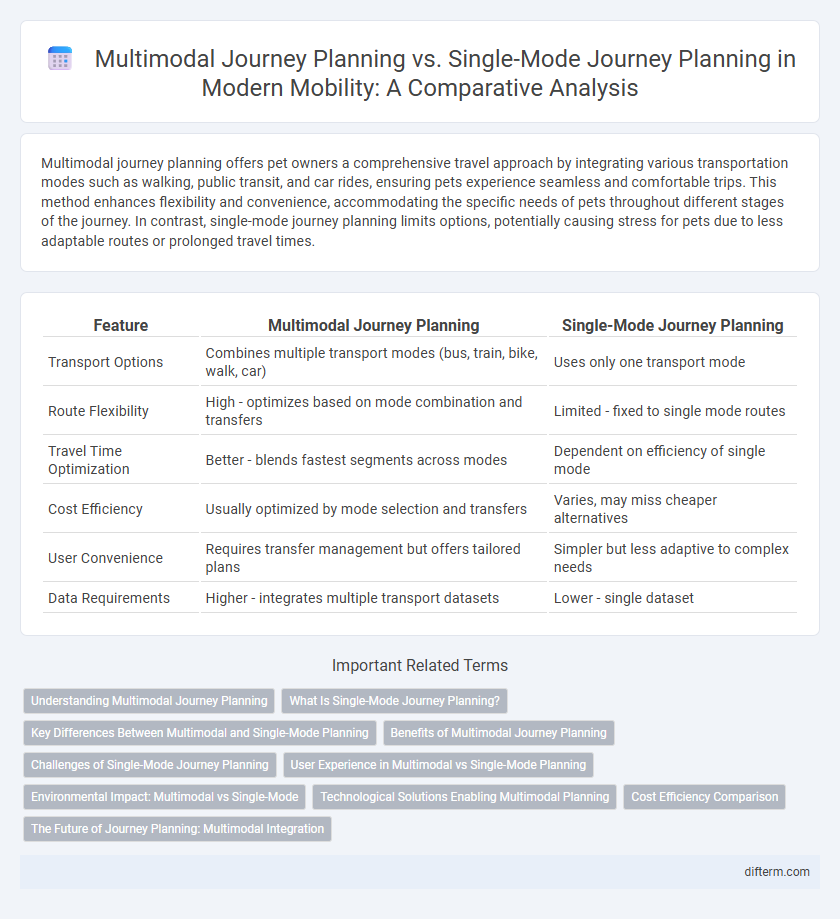Multimodal journey planning offers pet owners a comprehensive travel approach by integrating various transportation modes such as walking, public transit, and car rides, ensuring pets experience seamless and comfortable trips. This method enhances flexibility and convenience, accommodating the specific needs of pets throughout different stages of the journey. In contrast, single-mode journey planning limits options, potentially causing stress for pets due to less adaptable routes or prolonged travel times.
Table of Comparison
| Feature | Multimodal Journey Planning | Single-Mode Journey Planning |
|---|---|---|
| Transport Options | Combines multiple transport modes (bus, train, bike, walk, car) | Uses only one transport mode |
| Route Flexibility | High - optimizes based on mode combination and transfers | Limited - fixed to single mode routes |
| Travel Time Optimization | Better - blends fastest segments across modes | Dependent on efficiency of single mode |
| Cost Efficiency | Usually optimized by mode selection and transfers | Varies, may miss cheaper alternatives |
| User Convenience | Requires transfer management but offers tailored plans | Simpler but less adaptive to complex needs |
| Data Requirements | Higher - integrates multiple transport datasets | Lower - single dataset |
Understanding Multimodal Journey Planning
Multimodal journey planning integrates various transportation modes such as buses, trains, bicycles, and walking to optimize travel efficiency and reduce commute times. This approach leverages real-time data and route algorithms to provide dynamic travel solutions that adapt to traffic conditions, transit schedules, and user preferences. Compared to single-mode journey planning, multimodal systems enhance connectivity and sustainability by promoting seamless transitions across different transport options.
What Is Single-Mode Journey Planning?
Single-mode journey planning involves organizing travel using only one transportation mode, such as driving, cycling, or public transit, from start to finish. It focuses on route optimization, travel time estimation, and cost calculation within a single travel mode. This approach simplifies trip planning but may limit efficiency and flexibility compared to multimodal journey planning, which integrates multiple modes for optimal travel solutions.
Key Differences Between Multimodal and Single-Mode Planning
Multimodal journey planning integrates various transportation modes such as buses, trains, bikes, and walking to optimize travel time, cost, and convenience, unlike single-mode planning which relies on just one form of transit. Key differences include multimodal's emphasis on seamless transfers, real-time scheduling adjustments, and comprehensive route options, while single-mode planning focuses on route efficiency within a single transport system. Digital platforms supporting multimodal planning leverage advanced algorithms and data from multiple carriers to enhance user experience and reduce travel disruptions.
Benefits of Multimodal Journey Planning
Multimodal journey planning enhances travel efficiency by seamlessly integrating various transportation modes such as buses, trains, bikes, and walking, reducing overall travel time and costs. This approach optimizes route flexibility, improves accessibility in urban and rural areas, and decreases dependency on private vehicles, contributing to lower carbon emissions. By leveraging real-time data and smart routing algorithms, multimodal planning offers personalized, adaptive travel options that enhance user convenience and reduce congestion.
Challenges of Single-Mode Journey Planning
Single-mode journey planning often suffers from limited route options, leading to inefficient travel times and increased congestion on popular routes. It restricts users to one form of transportation, neglecting the benefits of integrating modes like walking, cycling, public transit, and ridesharing, which can optimize overall journey efficiency. The lack of flexibility in single-mode planning reduces adaptability to real-time traffic conditions and diverse user needs, hampering sustainable and seamless urban mobility.
User Experience in Multimodal vs Single-Mode Planning
Multimodal journey planning enhances user experience by seamlessly integrating various transportation modes such as buses, trains, bikes, and walking, offering flexible and efficient route options tailored to individual preferences. This approach reduces travel time uncertainty and increases convenience compared to single-mode journey planning, which limits users to one mode of transport and often requires manual coordination of transfers. Real-time updates and adaptive routing in multimodal systems further improve user satisfaction by providing dynamic, context-aware travel information.
Environmental Impact: Multimodal vs Single-Mode
Multimodal journey planning significantly reduces environmental impact by optimizing the use of low-emission transportation options like cycling, walking, and public transit, thereby decreasing reliance on high-emission single-mode vehicles such as private cars. Integrating diverse transport modes minimizes carbon dioxide emissions and traffic congestion, supporting sustainable urban mobility goals. Data from urban mobility studies indicate that multimodal trips can cut greenhouse gas emissions by up to 30% compared to single-mode journeys, highlighting their critical role in reducing the transportation sector's carbon footprint.
Technological Solutions Enabling Multimodal Planning
Technological solutions enabling multimodal journey planning integrate data from diverse transport modes, leveraging APIs, real-time traffic analytics, and AI-driven route optimization to offer seamless travel experiences. Advanced platforms combine public transit, ride-sharing, biking, and walking options into unified itineraries, enhancing efficiency and reducing travel time compared to single-mode journey planning. These innovations rely on IoT sensors, GPS tracking, and cloud computing to dynamically update routes and improve overall mobility management.
Cost Efficiency Comparison
Multimodal journey planning significantly reduces overall transportation costs by optimizing the use of various transit modes such as buses, trains, and shared mobility services, which often lowers reliance on expensive single-mode options like taxis or private cars. Integrating multiple transport modes enables dynamic route adjustments that minimize fuel consumption, toll expenses, and parking fees, resulting in enhanced cost efficiency for commuters. Data shows that travelers using multimodal planning can achieve up to 30% savings in travel expenses compared to single-mode journey planning.
The Future of Journey Planning: Multimodal Integration
Multimodal journey planning leverages real-time data from diverse transportation options such as buses, trains, bikes, and shared scooters, enabling seamless route optimization beyond the limitations of single-mode travel. Advanced AI algorithms integrate variables like traffic congestion, transit schedules, and environmental impact, providing personalized, efficient, and sustainable travel solutions. This evolution in journey planning supports urban mobility goals by enhancing accessibility, reducing carbon emissions, and improving user experience across interconnected transport networks.
multimodal journey planning vs single-mode journey planning Infographic

 difterm.com
difterm.com